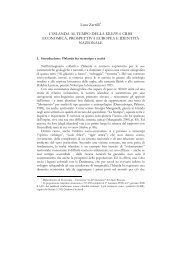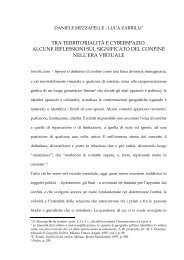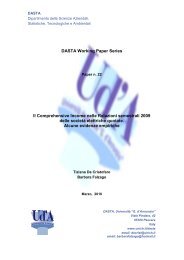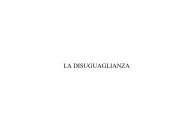DASTA Working Paper Series Life Cycle Assessment in the tourism ...
DASTA Working Paper Series Life Cycle Assessment in the tourism ...
DASTA Working Paper Series Life Cycle Assessment in the tourism ...
You also want an ePaper? Increase the reach of your titles
YUMPU automatically turns print PDFs into web optimized ePapers that Google loves.
<strong>DASTA</strong> – <strong>Work<strong>in</strong>g</strong> <strong>Paper</strong><br />
System boundaries The life cycle stages considered are <strong>the</strong> same as <strong>the</strong><br />
Sisman‟s study (see section 3.1) with <strong>the</strong> addition of <strong>the</strong> phase of air<br />
transportation of passengers to <strong>the</strong> dest<strong>in</strong>ation and return.<br />
Data quality The <strong>in</strong>formation used for <strong>the</strong> LCA is almost always of a<br />
qualitative nature. If quantitative, it is derived from literature or questionnaires.<br />
Environmental impact assessment method Both <strong>in</strong> <strong>the</strong> LCA referr<strong>in</strong>g to <strong>the</strong><br />
generic tourist product, and <strong>in</strong> <strong>the</strong> comparative LCA of alternative tourist<br />
products, <strong>the</strong> assessment of environmental impacts was carried out follow<strong>in</strong>g<br />
a qualitative matrix approach.<br />
Specific features In addition to <strong>the</strong> specific characteristics already reported<br />
for Sisman's study (see section 3.1)), we must stress that this second<br />
analysis commissioned by BAH reports what appears to be <strong>the</strong> first def<strong>in</strong>ition<br />
of a holiday <strong>in</strong> an LCA viewpo<strong>in</strong>t: «a holiday is a complex "product",<br />
assembled from a series of goods and services that enables a person to<br />
spend time at leisure at a given dest<strong>in</strong>ation» (UK CEED, 1998). <strong>Assessment</strong>s<br />
of economic and socio-cultural issues were also <strong>in</strong>cluded.<br />
Ma<strong>in</strong> limitations In addition to <strong>the</strong> shortcom<strong>in</strong>gs highlighted <strong>in</strong> <strong>the</strong> previous<br />
study, <strong>the</strong> authors <strong>the</strong>mselves recognize <strong>the</strong> limitation of not hav<strong>in</strong>g <strong>in</strong>cluded<br />
<strong>the</strong> processes which are extr<strong>in</strong>sic to <strong>the</strong> tourist dest<strong>in</strong>ation <strong>in</strong> <strong>the</strong> system<br />
boundaries; examples of those processes are <strong>the</strong> production of goods<br />
imported by <strong>the</strong> <strong>tourism</strong> <strong>in</strong>dustry (such as food grow<strong>in</strong>g and distribution) and<br />
activities that take place after <strong>the</strong> holiday (such as photo development)..<br />
3.3 IO-LCA of <strong>the</strong> US hotel <strong>in</strong>dustry (Rosenblum et al., 2000)<br />
Methodology IO-LCA.<br />
Product The analyzed area of <strong>in</strong>terest is tourist hotels.<br />
Objectives The assessment of direct and <strong>in</strong>direct effects of services on <strong>the</strong><br />
economy and <strong>the</strong> environment. In particular, <strong>the</strong> environmental impacts of <strong>the</strong><br />
follow<strong>in</strong>g service <strong>in</strong>dustries were compared, besides <strong>the</strong> hotel sector: truck<strong>in</strong>g<br />
and courier services, retail trade, colleges and universities.<br />
Data quality The data used are from literature. In particular economic data<br />
are from <strong>the</strong> US Input/Output tables (U.S. Department of Commerce, 1997,<br />
Lawson, 1997).<br />
Environmental impact assessment method The follow<strong>in</strong>g parameters and<br />
<strong>in</strong>dexes were adopted:<br />
resource use, <strong>in</strong>clud<strong>in</strong>g electricity, fuel use, ore and fertilizer consumption;<br />
total energy consumption, <strong>in</strong>clud<strong>in</strong>g consumption of electricity and fuels;<br />
toxic emissions (Toxics Release Inventory - TRI), based on release of 650<br />
toxic chemicals to air, water, land and underground wells;<br />
hazardous waste generation amounts from <strong>the</strong> Resource Conservation and<br />
Recovery Act (RCRA) data set;<br />
De Camillis, Raggi, Petti 6






